Direct regulation of myocardial triglyceride metabolism by the cardiomyocyte circadian clock
- PMID: 19940111
- PMCID: PMC2823428
- DOI: 10.1074/jbc.M109.077800
Direct regulation of myocardial triglyceride metabolism by the cardiomyocyte circadian clock
Abstract
Maintenance of circadian alignment between an organism and its environment is essential to ensure metabolic homeostasis. Synchrony is achieved by cell autonomous circadian clocks. Despite a growing appreciation of the integral relation between clocks and metabolism, little is known regarding the direct influence of a peripheral clock on cellular responses to fatty acids. To address this important issue, we utilized a genetic model of disrupted clock function specifically in cardiomyocytes in vivo (termed cardiomyocyte clock mutant (CCM)). CCM mice exhibited altered myocardial response to chronic high fat feeding at the levels of the transcriptome and lipidome as well as metabolic fluxes, providing evidence that the cardiomyocyte clock regulates myocardial triglyceride metabolism. Time-of-day-dependent oscillations in myocardial triglyceride levels, net triglyceride synthesis, and lipolysis were markedly attenuated in CCM hearts. Analysis of key proteins influencing triglyceride turnover suggest that the cardiomyocyte clock inactivates hormone-sensitive lipase during the active/awake phase both at transcriptional and post-translational (via AMP-activated protein kinase) levels. Consistent with increased net triglyceride synthesis during the end of the active/awake phase, high fat feeding at this time resulted in marked cardiac steatosis. These data provide evidence for direct regulation of triglyceride turnover by a peripheral clock and reveal a potential mechanistic explanation for accelerated metabolic pathologies after prevalent circadian misalignment in Western society.
Figures
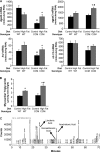
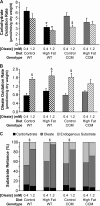
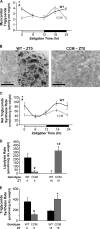
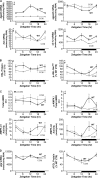
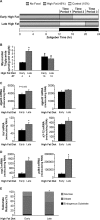
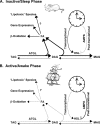
Similar articles
-
Disruption of the circadian clock within the cardiomyocyte influences myocardial contractile function, metabolism, and gene expression.Am J Physiol Heart Circ Physiol. 2008 Feb;294(2):H1036-47. doi: 10.1152/ajpheart.01291.2007. Epub 2007 Dec 21. Am J Physiol Heart Circ Physiol. 2008. PMID: 18156197
-
Altered myocardial metabolic adaptation to increased fatty acid availability in cardiomyocyte-specific CLOCK mutant mice.Biochim Biophys Acta. 2016 Oct;1861(10):1579-95. doi: 10.1016/j.bbalip.2015.12.012. Epub 2015 Dec 22. Biochim Biophys Acta. 2016. PMID: 26721420 Free PMC article.
-
Biotinylation: a novel posttranslational modification linking cell autonomous circadian clocks with metabolism.Am J Physiol Heart Circ Physiol. 2016 Jun 1;310(11):H1520-32. doi: 10.1152/ajpheart.00959.2015. Epub 2016 Apr 15. Am J Physiol Heart Circ Physiol. 2016. PMID: 27084392 Free PMC article.
-
Regulation of myocardial metabolism by the cardiomyocyte circadian clock.J Mol Cell Cardiol. 2013 Feb;55:139-46. doi: 10.1016/j.yjmcc.2012.06.016. Epub 2012 Jul 2. J Mol Cell Cardiol. 2013. PMID: 22766272 Free PMC article. Review.
-
Temporal partitioning of cardiac metabolism by the cardiomyocyte circadian clock.Exp Physiol. 2016 Aug 1;101(8):1035-9. doi: 10.1113/EP085779. Exp Physiol. 2016. PMID: 27474266 Free PMC article. Review.
Cited by
-
Influence of dark phase restricted high fat feeding on myocardial adaptation in mice.J Mol Cell Cardiol. 2013 Feb;55:147-55. doi: 10.1016/j.yjmcc.2012.09.010. Epub 2012 Sep 29. J Mol Cell Cardiol. 2013. PMID: 23032157 Free PMC article.
-
Chronic ethanol consumption disrupts the core molecular clock and diurnal rhythms of metabolic genes in the liver without affecting the suprachiasmatic nucleus.PLoS One. 2013 Aug 12;8(8):e71684. doi: 10.1371/journal.pone.0071684. eCollection 2013. PLoS One. 2013. PMID: 23951220 Free PMC article.
-
The Impact of the Circadian Genes CLOCK and ARNTL on Myocardial Infarction.J Clin Med. 2020 Feb 10;9(2):484. doi: 10.3390/jcm9020484. J Clin Med. 2020. PMID: 32050674 Free PMC article.
-
Interrelationship between 3,5,3´-triiodothyronine and the circadian clock in the rodent heart.Chronobiol Int. 2016;33(10):1444-1454. doi: 10.1080/07420528.2016.1229673. Epub 2016 Sep 23. Chronobiol Int. 2016. PMID: 27661292 Free PMC article.
-
Light phase-restricted feeding slows basal heart rate to exaggerate the type-3 long QT syndrome phenotype in mice.Am J Physiol Heart Circ Physiol. 2014 Dec 15;307(12):H1777-85. doi: 10.1152/ajpheart.00341.2014. Epub 2014 Oct 24. Am J Physiol Heart Circ Physiol. 2014. PMID: 25343952 Free PMC article.
References
-
- Bray M. S., Shaw C. A., Moore M. W., Garcia R. A., Zanquetta M. M., Durgan D. J., Jeong W. J., Tsai J. Y., Bugger H., Zhang D., Rohrwasser A., Rennison J. H., Dyck J. R., Litwin S. E., Hardin P. E., Chow C. W., Chandler M. P., Abel E. D., Young M. E. (2008) Am. J. Physiol. Heart Circ. Physiol. 294, H1036–H1047 - PubMed
-
- Durgan D. J., Moore M. W., Ha N. P., Egbejimi O., Fields A., Mbawuike U., Egbejimi A., Shaw C. A., Bray M. S., Nannegari V., Hickson-Bick D. L., Heird W. C., Dyck J. R., Chandler M. P., Young M. E. (2007) Am. J. Physiol. Heart Circ. Physiol. 293, H2385–H2393 - PubMed
-
- Martino T., Arab S., Straume M., Belsham D. D., Tata N., Cai F., Liu P., Trivieri M., Ralph M., Sole M. J. (2004) J. Mol. Med. 82, 256–264 - PubMed
-
- van den Buuse M. (1999) Physiol. Behav. 68, 9–15 - PubMed
Publication types
MeSH terms
Substances
Grants and funding
LinkOut - more resources
Full Text Sources
Molecular Biology Databases

